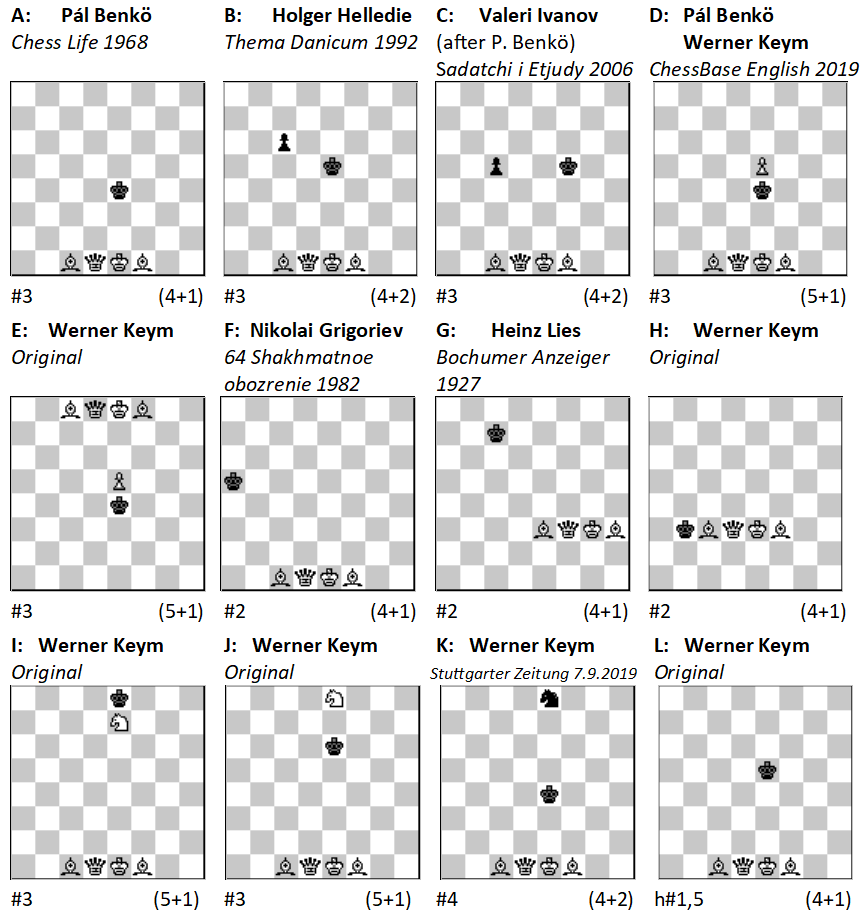


It was with great sorrow that we learned, this past August, of the passing of grandmaster Pal Benko.
Recently we showed you one of Pal's most elegant chess problems. It was composed when he was just fifteen but still occupied the author when he was in his nineties. The reason: the problem had in one line a dual.
.jpeg)
The solution (you can replay it against a chess engine in the above diagram): 1.♗c4! ♚f5 (1...♚e5 2.♕d5+ ♚f6 3.♕g5#) 2.♕f3+ (or dual 2.♕h5+ ♚f6 (2...♚e4 3.♕d5#) 3.♕g5#) 2...♚g6 3.♛f7#.
 The teenage Pal Benko never would have guessed how much mileage he was going to get out of that little composition. While the problem was pleasing on account of its simplicity and charm, Benko was not satisfied. He realized there was a dual on the second move (2.♕f3+ or 2.♕h5+).
The teenage Pal Benko never would have guessed how much mileage he was going to get out of that little composition. While the problem was pleasing on account of its simplicity and charm, Benko was not satisfied. He realized there was a dual on the second move (2.♕f3+ or 2.♕h5+).
Decades later a reader, N. Grigoriev (not to be confused with the late composer, Nikolai Grigoriev) wrote to the Russian chess magazine “64 Chess Review”. He had resurrected Benko’s problem and it took only two moves for checkmate.
The new version duly appeared in the September issue (64 Review #17, 1982). Unfortunately, it also ran into a cook, as pointed out by Benko. That was immediately corrected by Georgiev, but the new problem is very simple:
The solution of the original problem (left) is: 1.♕d4+ ♚a5 (1...♚b3 2.♕c4#) 2.♗d2#. But it is also solved with 1.♕d5 ♚a4 (1...♚c3 2.♕c4#) 2.♕b5#). Hard cheese. The correction (position right) has a very simple solution: 1.♕d6 ♚a4 2.♕a3#, no variations.
When he composed the problem (at fifteen, we remind you) Pal knew that it contained a dual. But he was told by experts: "Forget about dual, it is more elegant without additional material." The purity of the position made up for the dual. But problemists, fascinated by the position, have been looking for modifications that could make the problem completely dual free.
In our recent article, Pal Benkö and the Fischer challenge, we asked our readers to fire up their chess engines and look for a modification that makes Benko's problem perfectly dual free. Naturally the position had to retain the beauty and elegance of the original, and not change its basic character.
We received many proposals, and put the most interesting together for our readers. The positions were checked by problem expert Werner Keym, who gave brief evaluations of each of them. The best solution submitted by a reader came from Gregor Werner of Worms, Germany. It was the same version that Werner Keym had sent me some months ago. He had added a single white pawn on e5 to Benkö's original position, and with that eliminated the dual in the second move.
The solution: 1.♗c4! ♚f5 (1...♚xe5 2.♕d5+ ♚f6 3.♕g5#) 2.♕f3+ (After 2.♕h5+ because of the white pawn on e5 the black king cannot move to f6, and after 2...♚e4 White cannot play 3.♕d5#) 2...♚g6 (2...♚xe5 3.♕f4#) 3.♕f7#. No duals, but still not 100%, as was pointed out to me by Pal Benko: "I knew this correction, but it is weak — the ♕f7 mate is not clean." What he meant was that the problem contains a minor flaw in the final position of the main line given above. This mate after 3.♕f7 is not "clean" because the flight square f6 is covered by two pieces. Problemists frown on that.
Pal told me he had himself recently published an "improvement," two years ago, for the Hungarian Chess Day on some T-shirts. "Now I send you a photo taken on my 90th birthday with the T-shirt. It is much better with zugzwang and with chameleon-echo mates." I have put the picture on the front page — here is a diagram with the problem:
The solution, which you can execute without engine interference on the above board:
1.♗c4 ♚f6
or 1...♚f5 2.♕f3+ ♚g6 (2...♚e5 3.♕f4#) 3.♕f7#
or 1...♚e4 2. ♕g4+ ♚e5 3.♕f4#
or 1...c5 2.♕d5+ ♚f6 3.♕g5#
2.♕d6+ ♚g7 (or 2…♚f5 3.♕e6) 3.♕h6#.
In the above solution 1.♗c4 ♚f5 2.♕h5+ ♚e4 does not lead to mate in three as in the original problem. So adding a black pawn on c6 eliminates the dual in the original problem. The new version contains no duals and has a total of five mates, all "clean". There is zugzwang: after 1.♗c4 if Black did not have to move it would only be mate in four. "There is still one minor drawback," Pál wrote. "The key takes away an additional flight square (e6)." Problem composers try to avoid that.
After Pál had sent me his new position and the T-shirt picture (exactly two months before his passing) I received more positions from Werner Keym from professional composers trying to improve on Benkö's original problem. Two are outstanding: in Zadatchi i Etjudy 2006 Valery Ivanov submitted a version with the black king on f5 and a black pawn on c5, and one by Holger Helledie in Thema Danicum 1992 which is exactly the same as the last version Pál sent me.

And finally: recently the indefatigable Werner Keym sent me the above collection (click to enlarge) of Benkö variations. These are the key moves of the solutions: 1.♗c4! in A-D, 1.♗c5! in E, 1.♕d6! in F, 1.♕f5! in G, 1.♗d5! in H, 1.♗g5+! in I, 1.♕d6+! in J, 1.♗c4! in K, and 1.♗c4! in L. Note that it is not always a mate in three.
Keym has also shown that with the four white pieces in their original position, putting the black king on c3 or a5 is the only way to get dual-free direct mate positions. And he sent me a four-move problem based on Benkö that he has just published in the Stuttgarter Zeitung. It seems to me to be pretty perfect (no duals in the full length line, zugzwang, no flight squares taken by the key, all pieces move with exception of the white king:
Once again you can play through the solution without engine interference on the above board:
1.♗c4 (threatens 2.♕d5#) ♞f6!
or 1...♞c7 2.♕g4+ ♚e5 3.♕f4#
or 1...♚e5 2.♕d5+ ♚f6 3.♕g5#
or 1...♚f5 2.♕f3+ (or 2.♕h5+ ♚e4 (2...♚f6 3.♕g5#) 3.♕d5#) 2...♚g6 3.♕f7#)
2.♕d3+ ♚e5 3.♗g5! and zugzwang: the knight must move and allow 4.♕(x)d5#!
Quite astonishing — definitely worth replaying on the board.
 Pál Benkö, born July 14, 1928, was a Hungarian-American chess grandmaster, openings theoretician, author and problemist. He became Hungarian champion when he was twenty and finished in first place (or tied for first place) in a record of eight US Championships: 1961, 1964 (in that year he also won the Canadian Open Chess Championship), 1965, 1966, 1967, 1969, 1974, 1975. Benko's highest achievement was playing in the Candidates Tournaments with eight of the world's top players in 1959 and 1962. He qualified for the 1970 Interzonal Tournament, the leaders of which advance to the Candidates. However, he gave up his spot in the Interzonal to his friend Bobby Fischer, who went on to win the World Championship in 1972.
Pál Benkö, born July 14, 1928, was a Hungarian-American chess grandmaster, openings theoretician, author and problemist. He became Hungarian champion when he was twenty and finished in first place (or tied for first place) in a record of eight US Championships: 1961, 1964 (in that year he also won the Canadian Open Chess Championship), 1965, 1966, 1967, 1969, 1974, 1975. Benko's highest achievement was playing in the Candidates Tournaments with eight of the world's top players in 1959 and 1962. He qualified for the 1970 Interzonal Tournament, the leaders of which advance to the Candidates. However, he gave up his spot in the Interzonal to his friend Bobby Fischer, who went on to win the World Championship in 1972.
In addition to his success as a player, Benko is a noted authority on the chess endgame and a composer of endgame studies and chess problems. He is an over-the-board GM and also a FIDE IM of chess composition. The only other person we know who has these two titles is Jan Timman of the Netherlands. Pal Benko was also a dear friend who keeps in touch with us regularly, sending problems and puzzles for the ChessBase news page on special occasions.